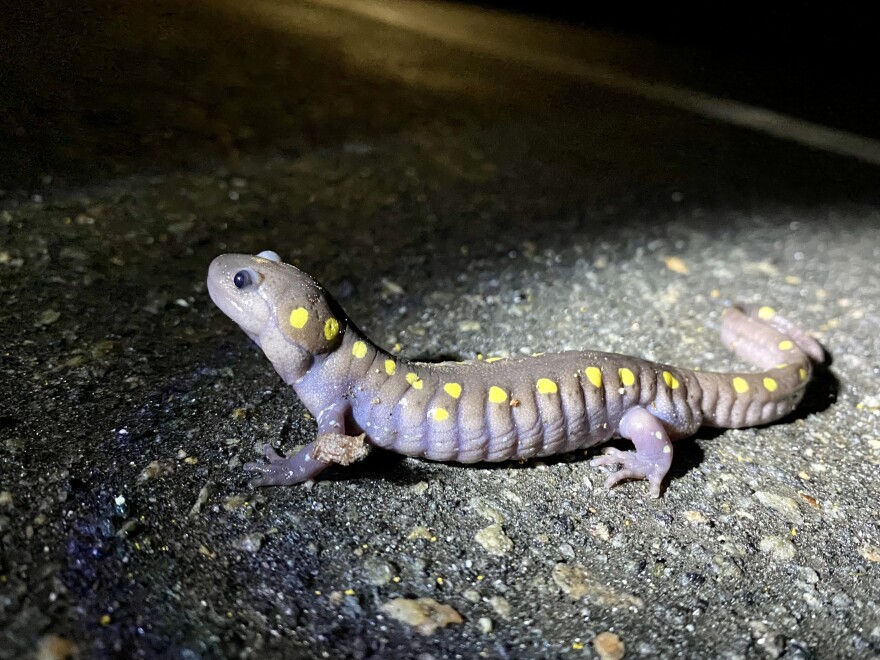When you think about the arrival of spring, there are probably a few things you look forward to — birds chirping, flowers blooming or maybe bears coming out of hibernation.
For Tim Abbott, a conservation director with the Housatonic River Valley Association, it’s the mass migration of amphibians.
"The first warm spring rains, usually in the middle of March, are the signal for a range of amphibians to emerge from hibernation," Abbott said. "If they move in sufficient numbers when the conditions are right, we call it a ‘big night’.”
In Northwestern Connecticut, the first so-called “big night” this year for salamanders, frogs and toads happened on March 23. Abbott was out in woods with other volunteers to see the animals in action.
"It had a light rain in the afternoon, and temperatures approaching 50. I have never seen so many salamanders in one spot, and I’ve been looking for 20 years, so it was perfect for them.”

In early spring, these tiny travelers will leave their underground homes to find vernal pools. Those are small, shallow bodies of water filled by rain or melting snow. Without water flowing in and out, they make a great place for these animals to breed. But, connectivity has become a big issue.
“In between where they spend the winter and most of their lifecycle under the leaves, upslope in the forest and where they would like to breed are roads, and they have to cross them," Abbott said.
Abbott and volunteers spotted and assisted 70 salamanders, as well as some wood frogs, spring peepers and more, as they crossed a state highway in Falls Village, Connecticut.
“The sad part about this story is you see a lot of carnage because cars hit them. So, I got out early enough that I was moving the first of them, but after an hour there were more than I could carry.”

That’s why Abbott believes it's important to bring more awareness to amphibians.
“You can’t just save one place and say that that species is fine because they use a mosaic of habitats," he said. "So, that little vernal pool at the bottom of the hill is very important for one part of the breeding cycle, but the forest and upland on the other side of the road is where they’re spending most of their time. And what’s in between is the gauntlet that they run."
One amphibian that’s particularly at risk is the eastern tiger salamander. Getting up to 13 inches in length with dark yellow spots, it is an endangered species in New York state. According to the state Department of Environmental Conservation, they are confined to Long Island, with only about 90 breeding ponds identified in recent surveys.
Frank Quevedo, executive director of the South Fork Natural History Museum, said that is because of overdevelopment in their habitat.
“The Long Pond Greenbelt on the East End of Long Island, a lot of people think that’s a lot of rural habitat, but it’s being overdeveloped slowly,” Quevedo said.

The museum was recently awarded a $30,000 grant from the Hollomon Price Foundation, to track the salamanders’ movement through the preserve over the next three years. The study is the first of its kind on Long Island’s East End.
“We need to get trained, to implant in each tiger salamander a small transmitter. And then next year when it’s breeding season again, in February and March, we’ll implant transmitters in the adults," Quevedo said. "We’re going to try to find out by tracking through radio-telemetry, what areas around their breeding ponds that they utilize.”
The preserve is made up of 1,900 acres of wetlands and coastal plain ponds, making it one of the most biodiverse ecosystems in New York state.
Quevedo said the goal of the study is to inform state and federal officials about the potential environmental impacts of building development there. "There’s still a lot of unanswered questions, such as the transmission cables under the preserve."
Utility company PSEG Long Island has proposed laying an underground transmission line between substations in Brookhaven and East Hampton, part of which would run right through the Greenbelt.
“What is the electro-magnetic field and the vibrations going to do to other animals such as snakes and turtles?" Quevedo asked. "And other salamanders, they’re pretty sensitive to vibrations and different senses.”
Quevedo believes the company is vastly underestimating the amount of area the salamanders utilize, and he hopes the study will prove it.
“They had said to the public that they only use 500 feet around their breeding ponds. And I truly believe that they use a lot more than that. I think they use 1,000 feet, if not more than that," he said.
There is no word on where that proposal stands right now, but Quevedo said the potential for development in the area is concerning.
“They are a food source for other animals such as herons and raccoons. But, they also oxygenate the soil by living underground and creating and living in these burrows of moles and voles, they oxygenate the soil which we use for farming. So, there is a direct connection there,” Quevedo adds.

In addition to informing developers, Quevedo hopes the study will educate the public about an animal that they might not have realized was in their own backyard.
"The only way you can protect something is to know about it first," he said. "So our mission is to provide that education, get people outdoors, have them feel and see things up close and first-hand. And then hopefully the tools will be given to them to become stewards of the environment in the future."

